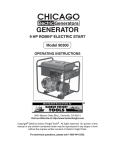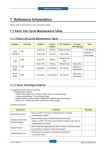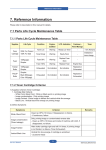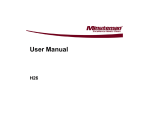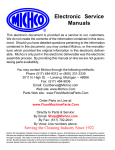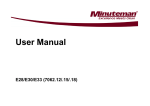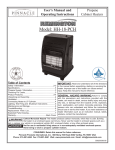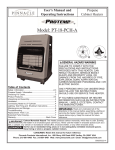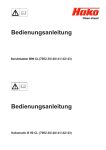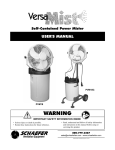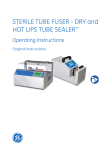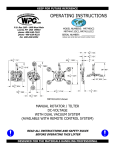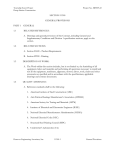Download User Manual Phoenix 35
Transcript
User Manual Phoenix 35 PowerBoss, Inc. A Member Of The Hako Group REV. 01A08 Introduction PrefaceIntroduction Dear customer, It is our desire that the good characteristics of the Phoenix 35 should justify the confidence you demonstrated by making this purchase. Prior to the first use, read the chapter "Safety Information” carefully as this will ensure safe operation of the machine. Your own safety, as well as the safety of others, depends to a great extent on how the machine is moved and operated. Therefore, this operation and maintenance manual must be read and understood prior to the machine being used for the first time. The manual provides valuable information about operation, service and maintenance. The warning symbols as used in this manual identifies items relevant to safety. Please observe the safety provisions (see chapter "Safety Information”). Your authorized PowerBoss dealer will be pleased to answer further questions regarding the machine or the operation and maintenance manual. 2 Please be advised explicitly that we cannot accept any legal issues out of the contents of this manual. If repair work has to be performed make sure that only genuine spare parts are used; only genuine spare parts may guarantee a dependable machine. We reserve the right for technical improvement.. Valid as of: March 2008 PowerBoss Inc. 175 Anderson Street NC 28315 U.S.A. Telephone: (910) 944-2105 (800) 982-7141 Fax: (910) 944-740 [email protected] Proper use The machine is a vacuum scrubbing machine for wet cleaning of hard-surfaced floors. Using the machine beyond this scope of application will be deemed improper use; The manufacturer cannot be held liable for consequential damages; the user alone bears the risk. The term of proper use also includes operation, maintenance and repair work to be performed in compliance with the manufacturer's specifications. The Phoenix 35 may only be used by persons that are familiar with the machine and aware of possible hazards involved. If modifications to the machine are made in absence of the manufacturer's prior consent, the latter cannot be held liable for damage resulting from such unauthorized modification. Introduction Notes on warranty The terms of the sales contract apply. Damages are not subject to warranty if they are due to non-compliance with the maintenance and service provisions. The maintenance work has to be performed by an authorized PowerBoss service center and confirmed in the "Maintenance certificate" which is the warranty document. The following is excluded from warranty: fuses, natural wear, damages caused by overload, inexpert handling and unauthorized modification of the machine. Moreover, any claim for warranty cannot be accepted if damages of the machine are caused by fitting parts or accessories without PowerBoss’s prior and explicit consent or by noncompliance with the maintenance instructions. Acceptance of the machine Upon arrival, check machine for possible damages in transit. For refund of such damage, contact your freight forwarder to confirm damage. Mail notification and waybill to: PowerBoss Inc. 175 Anderson Street NC 28315 U.S.A. Telephone: (910) 944-2105 Fax: (910) 944-740 3 Table of Content Introduction . . . . . . . . . . . . . Preface. . . . . . . . . . . . . . . . . . Proper use . . . . . . . . . . . . . . . Notes on warranty . . . . . . . . . Acceptance of the machine . . 1 1.1 1.2 1.3 1.4 1.5 1.6 4 2 2 2 3 3 1.7 Safety information . . . . . . . . 5 Safety and Warning Symbols . 5 General Provisions . . . . . . . . . 6 Provisions for Operation. . . . . 6 Maintenance instructions . . . . 7 Specific Hazards . . . . . . . . . . 7 Information for Protection of Environment . . . . . . . . . . . . . . . . 8 Labels at the Machine . . . . . . 9 2 2.1 2.2 2.3 2.4 2.5 2.6 2.7 2.8 2.9 First Operation . . . . . . . . . . 10 Instruction. . . . . . . . . . . . . . . 10 Initial charging procedure . . . 10 Before Putting into Operation 10 Start Machine . . . . . . . . . . . . 10 Operation . . . . . . . . . . . . . . . 11 Stop Machine . . . . . . . . . . . . 11 After Work . . . . . . . . . . . . . . 11 Transport rides . . . . . . . . . . . 11 Tie-down points . . . . . . . . . . 11 3 3.1 3.1.1 3.1.2 3.1.3 3.1.4 3.1.5 3.1.6 3.1.7 3.2 Operation . . . . . . . . . . . . . . 12 Method of operation . . . . . . . 12 Brush Head . . . . . . . . . . . . . 12 Solution Tank . . . . . . . . . . . . 12 Squeegee. . . . . . . . . . . . . . . 13 Recovery Tank . . . . . . . . 13 Travel Drive . . . . . . . . . . . . . 13 Batteries and Charger . . . . . 13 Options. . . . . . . . . . . . . . . . . 13 Operating and Indicating Elements . . . . . . . . . . . . . . . . . . 14 3.2.1 Operating Panel . . . . . . . . . . 14 3.2.2 At the machine . . . . . . . . . . . 17 4 Technical Data . . . . . . . . . . 20 5 5.1 Maintenance and Care . . . . 22 PowerBoss System Maintenance . . . . . . . . . . . . . . . . . . 22 Maintenance Document . . . . 23 Maintenance Schedule. . . . . 24 Battery Systems . . . . . . . . . . 28 Charge Batteries . . . . . . . . . 29 Low Discharge Signal sender (LDS) . . . . . . . . . . . . . . . . . . 29 Maintenance of Drive Batteries . . . . . . . . . . . . . . . . . . . . . . .29 Remove Batteries. . . . . . . . . 29 Install Batteries. . . . . . . . . . . 29 5.2 5.3 5.4 5.4.1 5.4.2 5.4.3 5.4.4 5.4.5 5.4.6 5.5 5.5.1 5.5.2 5.5.3 5.6 5.6.1 5.6.2 5.6.3 5.7 5.7.1 5.7.2 5.7.3 5.7.4 5.8 5.8.1 5.8.2 5.8.3 Disposal of Batteries . . . . . . . . . 29 Solution Tank . . . . . . . . . . . . . . . 30 Fill Solution Tank . . . . . . . . . . . . 31 Empty Solution Tank . . . . . . . . . 31 Clean Solution Filter. . . . . . . . . . 31 Recovery Tank . . . . . . . . . . . . . . 32 Empty Recovery Tank . . . . . . . . 33 Clean Recovery Tank . . . . . . . . . 33 Clean Suction Filter . . . . . . . . . . 33 Plate brush head . . . . . . . . . . . . 34 Clean Brushes . . . . . . . . . . . . . . 34 Change Brushes . . . . . . . . . . . . 34 Change Deflector Roller. . . . . . . 34 Change Sealing Strip . . . . . . . . . 34 Squeegee. . . . . . . . . . . . . . . . . . 35 Cleaning the Squeegee . . . . . . . 35 Changing the Squeegee blades...35 Adjusting the Squeegee blades . 36 EC-Declaration of Conformity . . . . . . . . . . . . . . . . . . . . . . . 39 Safety information 1 Safety information 1.1 Safety and Warning Symbols All paragraphs in this manual referring to your personal safety, the safety of your machine and the environment protection are attributed one of the following warning symbols: Symbol Hazardous for ... Description Safety Provisions persons and goods Safety Provisions in dangerous situation caused by misuse inaccurate adherence of instructions or prescribed work routine. CAUTION the machine important information on handling the machine in order to maintain operability. Ecological hazard the environment due to use of substances representing an inherent danger to health of environment 5 Safety information 1.2 General Provisions • Apart from the provisions contained in this instruction manual, the general safety provisions and the accident prevention regulations as imposed by law have to be complied with. • Before operating machine, carefully read this user manual as well as other separate instructions for accessories or attached implements and comply with all points mentioned there during work. • Persons being trained by qualified PowerBoss technicians only are authorized to operate, service and repair the machine. • You are advised to thoroughly study the safety instructions since precise knowledge helps prevent errors during machine operation and thus guarantee proper use of the machine. • The operating instructions have to be at hand at the place of use of the machine, and therefore have to be kept readily available at the machine. • When selling or letting the machine for rent, hand out these documents 6 to the new owner/operator and have the transfer certified! • The warning and instruction plates attached to the machine contain valuable advice about safe operation. Immediately replace incomplete or illegible labels. • As far as safety standards are concerned, spare parts must equal to genuine PowerBoss spare parts! 1.3 Provisions for Operation • Before first operation of the machine, fully charge the battery with an initial charging procedure and comply with the operating instructions of the charger as well as with those of the battery manufacturer. PowerBoss cannot be held liable for damages resulting from an insufficient initial charge. • Before operation, check the machine for operational safety! Immediately remedy malfunctions! • It is indispensable for the operator to get acquainted with all attached implements and controls as well as with their function before operation begins. • When working with the machine use firm and skid proof shoes. • The machine may be used only on such surfaces clearly specified by the owner or his authorized representative. • When working with the machine, pay strict attention to any persons in the close vicinity. • Start moving immediately after brush head has switch on otherwise the brush might leave traces on the floor. Lift the brush head before moving over obstacles (doorsteps). • Only fold open empty recovery tank. • Use only cleaning agents suitable for automatic machines (low-foaming) and comply with the instructions for use, disposal and with the warning information specified by the cleaning agent's manufacturer. • The machine is not designed for collecting hazardous, inflammable or explosive dusts or substances. • Usage of the machine in explosive areas is prohibited. • Pull the switching key to avoid unauthorized use of the machine. • Before transport of the machine, lift the squeegee and the brush head. Safety information Adapt driving habits to local conditions. • The machine may be used only for operation on flat floors with a maximum inclination of up to 10%. 1.4 Maintenance instructions • The daily and weekly maintenance and repair task must be performed by a qualified operator. For further maintenance and repair work beyond please contact your local PowerBoss service center. • Observe the maintenance activities and intervals set out in the instruction manual. • Maintenance and repair work may be carried out only by means of appropriate tools. • Have the machine checked for safe condition in the sense of the Accident Prevention Regulation by an expert at regular intervals (recommendation: at least once yearly) as well as after modifications or repair. • Spare parts must be equal to technical requirements as specified by the manufacturer! Genuine spare parts guarantee compliance with these requirements. • Switch off the engine and remove the key before inspecting the machine or performing any maintenance work. • To prevent the machine from being used by unauthorized persons, the control key must be removed. • When performing work at the electrical system, be sure to disconnect the battery plug. • Make sure to protect the recovery tank against accidental closing or tilting down before working in the area of a lifted tank lid. • Do not clean the electrical parts by means of high-pressure cleaning equipment. • The use of aggressive detergents is prohibited. • Let the machine dry after cleaning. • The machine may be taken into operation after all protective devices have been fitted and positioned. chine and remedy. • Only qualified personnel are authorized to work on the electrical installations and only according to electrotechnical rules. • Inspect/check the electrical equipment of the machine at regular intervalls. Clear up any defects immediately, such as loose connections or damaged cables. Battery • Respect the operating instructions of the battery manufacturer. • Never place metal objects or tools on batteries - short-circuit hazard! • Due to alteration of the center of gravity, only use batteries as released and at the prescribed position only. • Only charge batteries in areas with sufficient ventilation. – Explosion hazard! 1.5 Specific Hazards Electric system • Only use genuine fuses with the specified ratings. • In case of malfunction of the electric system, immediately shutdown ma7 Safety information 1.6 Information for Protection of Environment • For safe use of substances inheriting a danger to health and environment specific knowledge is required. • Observe the legal directives and local regulations for disposal of detergents, see Water Management Act. • Used batteries labeled as recyclable contain reusable economic goods. According to the crossed dustbin label these batteries must not be added to the normal waste. Provide an agreement with the PowerBoss contract dealer on their return and disposal. 8 Safety information 1.7 Labels at the Machine The following safety and information labels are legibly attached to the machine. Replace missing or illegible labels immediately. PowerBoss nameplate (Fig. 1/1) A = Read and observe the instruction manual (Fig. 1/2) B = Maximum inclination of 10% (Fig. 1/2) C = Do not clean the machine by means of high-pressure cleaning equipment (Fig. 1/2) 2 A 3 Machine identification number (Fig. 1/2) B 10 Recovery drain hose (Fig. 1/3) C 1 Fig.1 9 First Operation 2 First Operation 2.1 Instruction Instruction is required before first operation. First instruction into handling of the machine must be held by a qualified person sent by your local PowerBoss contract dealer. Your PowerBoss dealer will be informed by the manufacturer upon delivery of the vehicle and will contact you to make a date for instruction. 2.2 Initial charging procedure Before first operation of the machine, fully charge the battery with an initial charging procedure and comply with the operating instructions of the charger as well as with those of the battery manufacturer. PowerBoss cannot be held liable for damages resulting from an insufficient initial charge. 10 2.3 Before Putting into Operation Complete the following inspections before taking the machine into operation: 1. Check the area around the machine for signs of leakage. Hoses, lines and tanks must be free from any leakage or damage. 2. Install brushes and squeegee, see maintenance chapter. 3. Install batteries and connect battery plug, see maintenance chapter. 4. Check battery charge and proceed to re-charging of batteries if required. Generally proceed to initial charging before first operation of the machine. 5. Empty recovery tank and clean it if required, see maintenance chapter. 6. Re-fill solution tank and add cleaning agent according to the manufacturer's recommendations. Use only cleaning agents suitable for automatic machines (low-foaming) and comply with the instructions for use, disposal and with the warning information specified by the cleaning agent's manufacturer. 2.4 Start Machine Proceed with the following to set the machine to operating mode: • Disconnect AC plug of the charger from outlet and fasten to the holder. • Switch on machine by turning the key switch from position (0) to position (1). First Operation 2.5 Operation 1. Switch on the machine. 2. Use tip switch to lower squeegee. Suction turbine switches on automatically. 3. Switch on solution supply by means of the tip-switch (Fig. 4/14). 4. Adjust the solution amount by means of the tip-switch (Fig. 4/13) when brush head lowers solution supply switches on automatically. 5. Use the speed control knob (Fig. 5/ 1b) to adjust the working speed. Use the direction switch (Fig.5/1a) to select forward or reverse. Pull the bail handle (Fig. 5/1c) to start moving. Start moving machine immediately after switch on the brush head, otherwise the brushes leave traces on the floor. Lift brush head before passing over steps and other obstacles. 2.6 Stop Machine If release the accelerator lever, this returns automatically into the neutral position. The machine stops. Protect the machine against unintentional move- ments or against being inadvertently started. 2.7 After Work 1. Ride machine to suitable site for maintenance. 2. Stop machine, lift squeegee and brush head and remove the key. 3. Empty and clean recovery tank. Observe the legal directives and local regulations for disposal of detergents. 2.8 Transport rides To move the machine to the place where it is to be used, switch it on, liftout squeegee and brush head and actuate the accelerator switch according to the desired direction of travel. 2.9 Tie-down points In case of transport on a vehicle or trailer, the machine has to be protected against rolling off. Tie the machine down firmly by lashing it to the front with the eye bolts (Fig. 2/1) and to the rear with the chassis (Fig. 2/2) . 4. Check solution filter. 5. Check seals and suction hose. 6. Check operating fluid levels, function and setting. 7. Charge batteries. 8. Clean the machine. Empty the solution tank before shutting down the machine for a longer time. Do not clean the electrical parts by means of high-pressure cleaning equipment. 1 2 Fig.2 11 Operation 3 Operation 3.1 Method of operation General The Phoenix 35 is a vacuum scrubbing machine for wet cleaning of hard-surfaced floors. 3.1.1 Brush Head Lower brush head (Fig. 3/1) The brushes rotate and water supply 7 switch off automatically when the accelerator lever is in the neutral position (machine stopped). Likewise the brushes and water supply switch on automatically in forward position. 3 3.1.2 Solution Tank Fill the solution tank (Fig. 3/2) after folding up the opening. The solution tank holds 113 litres and the filling level can be seen through the transparent hose. Regulation of water amount is available via adjustment handle. 6 4 1 5 2 Fig.3 12 Operation 3.1.3 Squeegee The movable squeegee (Fig. 3/3) consists of the squeegee lift-out, the suction turbine and squeegee blades. The dirty water is wiped from the floor by means of the squeegee blades. Squeegee is lowered via tip switch. Simultaneously, the suction turbine switches on. The suction turbine works independent of direction of travel and even if the machine stops. Second actuation of the tip switch lifts the squeegee up again and suction turbine is automatically switched off with a delay of 15 seconds. 3.1.4 Recovery Tank The dirty water is taken from squeegee to the recovery tank (Fig. 3/4) by suction turbine and suction hose. For cleaning and collecting water at places where access is difficult, the machine can equipped optional with handheld suction hose. 3.1.5 Travel Drive The machine features a continuous travel drive (Fig. 3/6). The electronic drive control maintains travel speed, direction as well as dynamic braking. Accessories such as brushes, rollers, pads, pad holder with centerlock and squeegee blades are available. Contact your PowerBoss Dealer for more information. 3.1.6 Batteries and Charger The machine is equipped with an automatic charger unit (Fig. 3/7) and a low discharge signal sender (LDS) for protection against low discharge. 3.1.7 Options • Dosage system and floater unit for automatic filling • Extraction hose including suction pipe, joint nozzle and wet suction nozzle • Mop holder and tool-box for cleaning utensils • Silence Kit for soundproofed operation • Private-Label for additional labels. • Scrubbing tool • Handheld suction hose 13 Operation 3.2 Operating and Indicating Elements 1 3.2.1 Operating Panel 1 Display 2 Key switch 3 Battery charge indication 4 LDS indicator 5 Symbol brush drive 6 Symbol suction turbine drive 7 Hourmeter 8 Symbol Service indicator 9 Symbol Parking brake 10 Symbol Silence Kit (optional) 11 Symbol solution dosage 12 Tip-switch Silence Kit (optional) 13 Tip-switch solution dosage 14 Tip-switch solution supply On/Off 15 Symbol vacuum scrubbing tool (optional) 16 Tip-switch vacuum scrubbing tool (optional) 7 15 9 8 4 11 5 6 10 12 14 13 2 Fig.4 14 3 16 Operation Display (Fig. 4/1) This panel allows centralized monitoring of functions and detection of all available operating modes. The key switch turns the electrical system on and off. Remove the key to avoid unauthorized use of the machine. A B C D Battery charge indication (Fig. 4/3) Battery charge indication appears on the panel during the charging procedure and shows the current charge condition of batteries during the procedure. The following symbols appear: Battery symbol A < charge of 20 % Battery symbol B = charge of 80 % Battery symbol C = charge of 100 % Battery symbol D (flashes) = error 1.1.1.1 LDS indicator (Fig. 4/4) Upon switching unit on, the LDS indicator shows the current battery charge condition during operation. For dditional Information see chapter maintenance. Symbol brush drive (Fig. 4/5) This symbol appears when brush drive is switched on. Hourmeter (Fig. 4/7) Upon switching on, the hourmeter briefly displays the software version and the last error code. Then the current operating hour level is shown. Service indicator (Fig. 4/8) The service indicator lights after occurrence of a system error and cleaning or riding procedure is interrupted. In addition to the service indicator, a 4-digit code is displayed on the hourmeter. Symbol suction turbine drive (Fig. 4/6) This symbol appears when suction turbine drive is switched on. 15 Operation Parking brake symbol (Fig. 4/9) This symbol appears if control lever is in neutral position and travel drive will be locked. Silence Kit tip-switch (optional) (Fig. 4/12) This tip-switch is used to change suction turbine to silent mode. The silent mode symbol appears in the display. Silence Kit tip symbol (optional) (Fig. 4/10) This symbol appears when Silence Kit tip-switch is switched on. Solution dosage tip-switch (Fig. 4/13) This tip-switch is used to regulate the amount of solution. Additionally, solution amount is adapted to driving speed. The display shows a sixstage symbol for the supplied amount of solution. Solution dosage symbol (Fig. 4/ 11) This symbol appears upon actuation of the solution dosage tip-switch. 16 Solution supply ON/OFF tipswitch (Fig. 4/14) This tip-switch is used to switch solution supply ON or OFF. Scrubbing tool symbol (optional) (Fig. 4/15) This symbol appears when scrubbing tool-switch (A) (Fig. 4/16) is switched on A Operation 3.2.2 At the machine 1 Drive direction control (1a) with speed control knob (1b) and bail handle (1c) 2 Opening of solution tank 3 Drity water vacuum hose 4 Solution filter 5 Soiled water drain hose 6 Solution level indication 7 Brush ejector 8 Power connection charger unit 9 Hand lever for squeegee lift-out 10 Pedal brush head 11 Scrub brush head pressure 7 4 6 9 2 8 1 3 10 11 C A 5 B Fig.5 17 Operation Drive direction control with speed control knob/bail handle (Fig. 5/1) The drive direction control (1a) is used to control the driving direction (forward or reverse). The bail handle (1c) must be pressed in order to drive. The speed can be adjusted continuously by means of the speed control knob (1b). The machine stops when the bail handle is released (deadman function). Protect the machine against rolling off before leaving it unattended. Opening of solution tank (Fig. 5/2) The solution water tank is filled after folding up the opening. Dirty water vacuum hose (Fig. 5/3) This hose transports the dirty water from squeegee to recovery tank. Solution filter (Fig. 5/4) While solution flows from tank to squeegee, it is cleaned by the filter element. Recovery Tank drain hose (Fig. 5/5) 18 This hose allows draining the collected dirty water from the tank. Solution drain hose (Fig. 5/6) This hose allows draining the solution tank. Brush ejector (Fig. 5/7) The brush ejector makes brush removal fast and easy. AC Power connection for charger unit (Fig.5/8) The power connection supplies the charger unit with power. Hand lever for squeegee lift-out (Fig.5/9) Use this hand lever to lift and lower the squeegee. Pedal brush head (Fig. 5/10) Use this pedal to lift and lower the brush head. Pedal plate brush head pressure (Fig. 5/11) This pedal allows increasing the ground pressure of the plate brush head. Operation Swing aside squeegee Swing aside the squeegee in lifted-out position to allow passage through narrow clearances. This can be done by foot or by hand by swinging the squeegee to the left in the area of the deflector bail / deflector roller until the locking pin (Fig. 6/1) catches. In order to release locking of the squeegee, activated the tip switch (Fig. 5/9). 1 Fig.6 19 Technical Data 4 Technical Data Unit of measure Machine length Machine height Machine width without Squeegee Machine width with Squeegee Working width Squeegee width Surface performance theoretical Service voltage Nominal power drive motor Nominal power suction motor Nominal power brush motor Number of brushes Diameter of brushes Speed Working Solution tank Recovery tank Weight without batteries and solution Weight with solution and batteries 20 Scrub brush head in 68 in in in in in ft²/h V W W W Qty. in Mph 44 35 44 33 44 36600 24 430 520 2x935 2 17 3,0 gallon gallon lbs lbs 30 30 496 1155 Technical Data Metric unit Standard dB (A) 82 80 79 dB (A) 67 65 63 dB (A) 1.6 1.6 1.6 m/s² < 2,5 < 2,5 < 2,5 Noise emission The sound pressure level measured under maximum conditions of use (LwA) according to DIN EN 60335-272 amounts to: The sound pressure level measured (at the ear of the driver) under normal conditions of use (LpA) according to DIN EN 60335-2-72 amounts to: Measurement inaccuracy (KpA): Soundproofing Soundproofing pack pack/ Silence Kit Vibration The frequency weighted acceleration measured according to DIN EN ISO 5349 which have an effect upon the upper limbs (hand-arm-system) amounts under normal working conditions: 21 Maintenance and Care 5 Maintenance and Care General Before proceeding to maintenance and care work you are advised to read and comply with the Safety Information chapter! Compliance with the recommended maintenance work will ensure that you always have a reliable machine available. Daily or weekly maintenance and repair work may be executed by the driver/ operator having been trained accordingly. Further PowerBoss system maintenance work must be completed executed by qualified personnel only. Please contact your local PowerBoss Service Center or PowerBoss contract dealer. We cannot be held liable for damages resulting from non-compliance with these instructions. Please indicate the machine's serial number with any inquiry or spare part order, see paragraph 1.7 - Nameplate. 22 5. PowerBoss System Maintenance The PowerBoss System Maintenance: • guarantees reliable operability of the PowerBoss machines (preventive maintenance) • minimizes operating costs, repair costs and maintenance costs • ensures long service life and operability of the machine The PowerBoss System Maintenance is structured in separate modules and determines specific technical works to be executed as well as the intervals for such maintenance work. For any specific maintenance type, the replacement parts are determined and listed in spare part kits. System Maintenance K: To be performed by the customer in accordance to the maintenance and care instructions contained in the operating instructions (daily or weekly). The driver/operator will be instructed upon delivery of the machine. System Maintenance I : (every 125 hours of operation) To be performed by qualified personnel of authorized PowerBoss Service Center in accordance with the machine-specific system maintenance including spare part kit. System Maintenance II: (every 250 hours of operation) To be performed by qualified personnel of authorized PowerBoss Service Center in accordance with the machine-specific system maintenance including spare part kit. System Maintenance S: (every 500 hours of operation safety check) To be performed by qualified personnel of authorized PowerBoss Service Center in accordance with the machine-specific system maintenance including spare part kit. Maintenance and Care 5.2 Maintenance Document Handing over Upgrade Test drive Handing over to the customer System Maintenance I 125 operating hours System Maintenance II 250 operating hours System Maintenance I 375 operating hours Workshop stamp Workshop stamp Workshop stamp Instruction carried out on: carried out on: carried out on: carried out on: at _________________ operating hours at _________________ operating hours at _________________ operating hours System Maintenance S 500 operating hours System Maintenance I 625 operating hours System Maintenance II 750 operating hours System Maintenance I 875 operating hours Workshop stamp Workshop stamp Workshop stamp Workshop stamp at _________________ operating hours carried out on: carried out on: carried out on: carried out on: at _________________ operating hours at _________________ operating hours at _________________ operating hours at _________________ operating hours System Maintenance S 1000 operating hours System Maintenance I 1125 operating hours System Maintenance II 1250 operating hours System Maintenance I 1375 operating hours Workshop stamp Workshop stamp Workshop stamp Workshop stamp carried out on: carried out on: carried out on: carried out on: at _________________ operating hours at _________________ operating hours at _________________ operating hours at _________________ operating hours 23 Maintenance and Care 5.3 Maintenance Schedule System Maintenance Customer The daily and weekly maintenance intervals must be performed by the customer/operator. Interval To be performed daily 24 Fill solution tank and proceed to chemical agent dosage o Charge batteries o Check brush head and clean if required o Check squeegee and clean if required o Clean tank lid seal of the recovery tank o Empty recovery tank. Clean recovery tank and suction filter o weekly Check brushes/pads and replace if required o Clean suction hose of recovery tank o Check squeegee sealing strips and turn around or replace if required o Clean drain hose of solution tank o Check solution supply to brushes and clean if required o Check solution filter and clean if required o Test drive and function test o Maintenance and Care System Maintenance I The following maintenance work must be performed by an authorized PowerBoss Service workshop. Interval To be performed every 125 hours of operation Check battery charger o Check tank lid seal of the recovery tank and replace if required o Check drain hose of the recovery tank and replace if required o Grease joints at the brush lift-out o Check wheel fixing screws and tighten (24 lb ft) if required o Check condition of tires o Grease joints at the squeegee holder o Test drive and function test o 25 Maintenance and Care System Maintenance II The following maintenance work must be performed by an authorized PowerBoss Service workshop. Interval To be performed every 250 hours of operation 26 Perform maintenance works according to System Maintenance I o Inspect steering rollers for tread damages and bearing slackness and replace if required o Check drain hose of the recovery tank and replace if required o Check deflector roller of the brush head and replace if required o Check suction hose for tight fitting and damages and replace if required o Check supporting wheel of the squeegee and replace if required o Test drive and function test o Maintenance and Care System Maintenance S (Safety check) The following maintenance work must be performed by an authorized PowerBoss Service workshop at least once a year. Interval To be performed every 500 hours of operation Perform maintenance works according to System Maintenance II o Clean travel drive motor from carbon dust and check carbon brushes for smooth operation and wearing and replace carbon brushes if required o Clean brush motors from carbon dust and check carbon brushes for smooth operation and wearing and replace carbon brushes if required o Test drive and function test o 27 Maintenance and Care 5.4 1 2 3 4 5 6 7 8 9 Battery Systems 1 2 8 LDS display Charger indicator Charger AC cable for charger Battery plug Batteries Recovery tank Support Wiring diagram 7 Handling and changes of the batteries may take place only by maintenance staff. During operation, the LDS indicator displays the battery charge status. When the batteries are empty, the battery icon flashes and an acoustic warning signal is issued. The machine functions are restricted. Drive to a charging station immediately.! 9 3 Fig.7 28 6 5 4 Maintenance and Care 5.4.1 Charge Batteries Use the integrated battery charger (Fig. 7/3) to charge batteries. Proceed to connection of the charger by means of the ac power cable (Fig. 7/4) with safety plug. Charging batteries is recommended if at least one bar of the LDS display has extinguished after operation of the machine. You should observe the operating instructions of the charger as well as the operating instructions of the battery manufacturer. Proceed to proper initial charging of the batteries before operation of the machine. PowerBoss cannot be held liable for battery damages resulting from non-execution of initial charging. In case it is intended to change the type of battery the charger has to be adjusted only by PowerBoss contract workshops. Provide for sufficient ventilation of areas where batteries are charged. – Explosion hazard! 5.4.2 Low Discharge Signal sender (LDS) The machine has been equipped with a charge indicator to preclude the batteries from low discharge. This low discharge signal sender has been integrated into the electronics. If other batteries are used, re-adjustment of the low discharge signal sender is required. Only PowerBoss contract workshops are authorized to proceed to adjustment of the low discharge signal sender. 5.4.3 Maintenance of Drive Batteries Refer to operating instructions 88-602556 for information on care of drive batteries. 5.4.4 Remove Batteries 1. Park machine on level ground. 2. Switch off machine by key switch. 3. Open empty recovery tank (Fig. 7/7) and secure by support (Fig. 7/8). 4. Disconnect battery plug (Fig. 7/5). 5. Disconnect battery connection cables. 6. Remove batteries. 5.4.5 Install Batteries Due to alteration of the center of gravity, only use batteries as released and at the prescribed position only. 1. Switch off machine by key switch. 2. Open empty recovery tank (Fig. 7/7) and secure by gas pressure spring (Fig. 7/8). 3. Place batteries into trough according to figure. 4. Connect battery poles and enclosed connecting cables according to wiring diagram (Fig. 7/9). Provide for tight fitting and grease poles. 5.4.6 Disposal of Batteries Used batteries labelled by the recycling sign contain re-usable substances. According to the labelling by crossed dustbin, such batteries must not be added to normal household waste. Contact your local PowerBoss contract partner for return and recycling. 29 Maintenance and Care 5.5 Solution Tank 5 1 2 3 4 5 Solution tank Marker Fill level hose Solution filter Tank lid 2 3 1 4 Fig.8 30 Maintenance and Care 5.5.1 Fill Solution Tank Fill solution tank (Fig. 8/1) before work or as required. Park vehicle on level ground. Open tank lid (Fig. 8/5) and fill tank up to the maximum (1/1 marker) (Fig. 8/2). Alternatively, filling of the machine via quick coupling (Fig. 8/6) is available. Before doing so, connect the filling hose of the dosage unit and the quick coupling. The floater valve automatically closes after the maximum filling level has been attained. (Refer to specific operating instructions for information on operation of the dosage unit) The maximum admissible service pressure of the floater unit is 6bar. 5.5.3 Clean Solution Filter Check solution filter (Fig. 8/4) at weekly intervals and clean or replace if required. Only clean solution filter with emptied solution tank. 1. Empty solution tank (Fig. 8/1) entleeren, see paragraph 5.5.2. 2. Unscrew filter cap. 3. Remove the filter element from the filter case for cleaning. Replace if required. 4. Re-install filter element and filter cap. 5.5.2 Empty Solution Tank Park vehicle such that the fill level hose (Fig. 8/3) is located above the drain aperture in the floor. Take fill level hose from holder and remove lid. 31 Maintenance and Care 5.6 1 2 3 4 Recovery Tank Recovery Tank Drain hose Suction filter Tank lid 4 1 2 3 Fig.9 32 Maintenance and Care 5.6.1 Empty Recovery Tank Clean recovery tank (Fig. 9/1) at daily intervals, as required or upon acoustic signal (increased suction turbine speed). 1. Take machine to appropriate place for discharge. 2. Park machine such that drain hose attains drain aperture in the floor. 3. Switch off machine. Observe the legal provisions and the local regulations for disposal of detergents! 4. Take drain hose (Fig. 9/2) from holder and empty recovery tank completely. 5.6.2 Clean Recovery Tank Clean recovery tank (Fig. 9/1) at daily intervals or as required. 1. Empty recovery tank, see paragraph 5.6.1. 2. Open tank lid (Fig. 9/4) of the recovery tank. 3. Take drain hose (Fig. 9/2) from holder and empty recovery tank completely. 4. Remove remaining debris by rinsing with clear water. 5. Rinse drain hose as well. 5.6.3 Clean Suction Filter Check suction filter (Fig. 9/3) for function at daily intervals and clean if required. The suction filter is clipped and can be easily removed. 33 Maintenance and Care 5.7 1 2 3 4 5 5.7.1 Clean Brushes Clean brushes of the brush head (Fig. 10/2) at daily intervals or as required. Press brush ejectors (Fig. 10/3) down to remove brushes for cleaning. Plate brush head Toggle-type fastener Brush head Brush ejectors Deflector roller Sealing strip 5.7.2 Change Brushes Check brushes of the brush head for wearing at weekly intervals. Replace brushes if bristles are worn down to a length of 1.5 cm. 1. Press brush ejectors (Fig. 10/3) down to remove old brushes. 2. Push new brush under brush head and use both hands to press it into seating. 5.7.3 Change Deflector Roller Check deflector roller (Fig. 10/4) at weekly intervals or replace as required. 4 5.7.4 Change Squeegee Blades Check squeegee blades (Fig. 10/5) at weekly intervals or as required. Before doing so, open toggle-type fastener (Fig. 10/ 1) and remove squeegee blade. Proceed to mount in inverse order. 2 Fig.10 34 1 5 3 Maintenance and Care 5.8 5.8.1 Cleaning the Squeegee Tool Check the squeegee (Fig. 11/1) daily and clean as necessary. To clean it lift the squeegee out, pull off the suction hose (Fig. 11/4), loosen the two star-shaped knobs (Fig. 11/2) and remove the squeegee. Squeegee Tool 1 Squeegee blade 2 Star-shaped knob 3 Eccentric wheel for angle adjustment 4 Suction hose 5 Fastening device 6 Washers for height adjustment 1 6 2 4 5 3 2 5.8.2 Changing the Squeegee Blades Check the inner and outer squeegee blades on the squeegee tool (Fig. 11/1) weekly for signs of wear. The blades can be used fourfold by turning them. 1. With Squeegee in raised position. 2. Pull off the suction hose, loosen the two star-shaped knobs and remove the squeegee tool. 3. Unlock the fastening device (Fig. 11/ 5) and remove the outer squeegee blade. Turn the blade or install a new one, as necessary. Change the inner blade in the same way. 6 Fig.11 35 Maintenance and Care 5.8.3 Adjusting the Squeegee Tool Angle Adjustment The angle adjustment is the decisive factor in ensuring that the squeegee blade on the squeegee tool lie evenly on the floor. 1. Park the machine on a level surface and lower the squeegee. 2. Loosen the srews on the eccentric wheel (Fig. 12/1) and adjust the squeegee using the eccentric wheel (SW13) so that the ends of the blade still have contact with the floor. Figure A: Turn the eccentric wheel in the front top position: The clearance between blade and floor is reduced in the center. Figure B: Turn the eccentric wheel in the behind top position: The clearance between blade and floor is increased in the center. 3. Switch the machine on and check the suction pattern. When the machine is in operation, the entire surface of the sealing strips (center and outer areas) must be applied as evenly as possible. 4. Tighten the srews on the eccentric wheel at 5 lb ft. 36 1 A 1 B Fig.12 Maintenance and Care Height Adjustment The height adjustment is set to 3 mm at the factory. If streaks are produced, despite an optimum angle adjustment, the clearance between the rollers and floor must be adjusted by changing the number of washers on the holder. 3 mm In the case of very smooth floors, e.g. finished floors, PVC, linoleum, etc. Number of washers = 2. This corresponds to a clearance of approx. 2 mm. 2 mm 4 mm In the case of very uneven floors, e.g. poorly laid tiles (water does not run off) Number of washers = 4. This corresponds to a clearance of approx. 4 mm. The Squeegee 110 cm is equipped with two additional rollers which are adjusted at the factory to a distance of 10 mm to the floor by means of spacers. Fig.13 37 Maintenance and Care 38 EC-Declaration of Conformity (according to Directive 98/37/EC) PowerBoss Inc. 175 Anderson Street NC 28315 U.S.A. Telephone: (910) 944-2105 Fax: (910) 944-740 declare under our sole responsibility, that the product Phoenix 35 Type: 7311 For the relevant implementation of the safety and health requirements mentioned in the Directives, the following standard (s) and / or technical specification (s) has (have) been respected: DIN EN 60335-2-72 DIN EN 61000-6-2 DIN EN 61000-6-3 to which this declaration relates, corresponds to the relevant basic safety and health requirement of the Directive 98/ 37/EC, and to the requirements of the other relevant Directives: 89/336/EEC. B 39










































